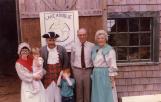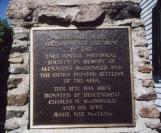14
The MacDonald descendants - Ann, Jessica, Charles, Bobby, Charles N., Jessieca. 1990
East Lake Ainslie, Inverness County, NS

15
At some point in the 1850's Charles became the first merchant in the Lake Ainslie area. His store was located below his home on the family land. A register from the store is currently housed at the Beaton Institute in Sydney. The foundation of the store is still visible, but local people have no recollection of the store still standing. There is very little in the way of documentation of the store other then the register. Charles' brother Donald married the Hon. William McKeen's daughter and moved to Mabou where he also was a merchant.Charles served as the Post Master for East Lake Ainslie from 1867 until his death in 1897 (Lake Ainslie Historical Society, MacDonald House Brief History). Charles wife Hannah took over the role of Post Master until 1925 when her son Dan C. took over. The Post Office remained in the MacDonald home until the current rural Route delivery system was implemented in the 1950's. The post office played a vital role in community life. Not only was it the place to go to get the mail, but it became a source of local information and gatherings. The mail arrived twice a week and it was always an event. The Post Office was nothing like ones we see in today's life. The mail was stored and sorted in the family dining room on a small desk in the corner. The door to the dining room had a small sliding hatch where the Post Master could pass mail to patrons. However, local history tells us that this was not the way the Macdonald's post office operated.
16
Drawing of floor plan of dining room in MacDonald House30 July 2007
East Lake Ainslie, Inverness County, NS
 Credits:
Credits:Malcolm Gillis
17
The MacDonald's post office was much more informal then the structure of the space would imply. Many of the patrons to the Post Office would come in the back door on mail day without waiting for an invitation to come in. They would sit on the bench (day-bed) in the kitchen and chat with the MacDonald's and perhaps have a cup of tea and a biscuit. It became more about the visit then about the mail in some ways. Locals would meet up with each other in the kitchen at MacDonald house, share stories and catch up on which farmers' sheep had lambed or whether the lake had frozen or thawed, or whose crops were ready to harvest. It is possible that many of the shared work gatherings, for harvesting, wool-spinning or barn building, were planned in the MacDonald's kitchen. Most everyone in the area was there on a weekly basis and this may have been the best way to spread word around before the advent of telephones.18
Post office in MacDonald House dining roomca. 1999
East Lake Ainslie, Inverness County, NS
 Credits:
Credits:Pauline MacLean
19
There is one story that I would like to relate that I feel shows quite a bit about the importance of getting the mail, and how important work was to local farmers. A family of MacKinnon's lived on a farm half a mile north of the MacDonald's. One of the girls in this MacKinnon family told me this story one summer while I was working at MacDonald House. She remembers that once when she was approximately 5 or 6 years old her entire family was out in the fields planting the summer's potato crop. The sky looked as though it would rain soon, and her father was anxious to get the whole field planted before that would happen. He was also very anxious to get to the post office to get a letter that he knew was coming. Instead of going himself to the post office or sending one of his older children who were needed in the field he sent his 6 year old daughter. He put her up on one of his horses, a trusted and calm horse. The horse was so used to going for the mail that the girl's father was able to lead the horse through the gate and tell it to go for the mail. The horse carried this six year old girl all the way to the back door of the MacDonald house where she hollered for someone's attention. Dan C MacDonald was Postmaster at this time, and he came out to the back door to see what the fuss was all about. He was quite shocked apparently to see this young girl alone on the horse. She asked for the mail and received it. Then she had to ask Dan C to tell the horse to go home as she was unable to use the reigns to guide it back. She made it home safely with the important letter (no one remembers what the letter might have been), and the potatoes got planted before the rain came.Another factor comes into play when looking at the MacDonald house as a gathering place for neighbours. Dan C played the fiddle quite well. The house was often the site of parties and ceilidh's. People would come on Saturday nights to the front room at the house to dance, hear the fiddle and socialize. There were many other people who played instruments as well but the fiddle was by far the most common.
In terms of the overall importance of the McDonald house and the MacDonald family to Lake Ainslie's heritage one need only look at the fact that the house and some of it's contents were deemed important enough by community members that they decided to transform it into a museum designed to preserve the memory of the people places and things important to Lake Ainslie residents.
21
MacDonald House as a monument to local heritageIn 1978 the dream of many residents of Lake Ainslie came to life. The home of the Dan C. and Mary Jessie MacDonald was deeded to the Lake Ainslie historical Society for use as a museum. The Lake Ainslie Historical Society comprised a group of community members who "were interested in preserving, in a manner as authentically as is possible, the names, dates, and all historical data relating to the pioneers of this area" (Lake Ainslie Historical Society, promotional brochure, date unknown). It took a few years to bring everything together; the official opening of the MacDonald House Museum was celebrated on August 18th, 1984 however the museum had been entertaining guests prior to the Official Opening (Lake Ainslie Historical Society, Official Opening Program transcript). The crowd gathered to celebrate this momentous occasion was addressed by such people as local historian and founding Lake Ainslie Historical Society member Peter MacMillan, descendant of the original MacDonald settlers Charles N MacDonald, Reverend Donald Sutherland, Past President of the Federation of Nova Scotian Heritage James O St.Clair, the Minister of Recreation, Fitness and Culture the Honourable Billy Joe MacLean, MLA for Inverness North the Honourable John Archie MacKenzie, the Honourable Senator Allan J MacEachen, and member of the Lake Ainslie Historical Society Chris Campbell. Also in attendance was Mrs Jessie Cameron, daughter of Charles MacDonald who at that time was in her one hundredth year.
22
Cairn to honour the pioneers on the grounds of MacDonald Houseca. 1990
East Lake Ainslie, Inverness County, NS

23
Charles N MacDonald's remarks on the day of the official opening gave a brief history of the family and their life and work. He also spoke of the house as a center for many activities and expressed his desire to see that tradition continue. James O St.Clair, who had consulted with the Lake Ainslie Historical Society members throughout the previous few years spoke of the many ‘firsts' that have and occurred at this house, the first store, the first post office and "the first official opening of building which is designated as a heritage house" in Inverness County (Lake Ainslie Historical Society, Official Opening Program transcript). The County of Inverness designated two properties as being a Heritage Property that year, the Smyth house in Port hood and the MacDonald house. He spoke also of the effort put forth by the membership of the Lake Ainslie Historical Society in terms of gathering and collecting oral and written history and of their commitment to educating themselves by attending seminars offered by the Federation of Nova Scotia Heritage.25
MLA John Archie MacKenzie's remarks reflected his own memories of the hospitable nature of the MacDonald family during his trips to the area as a child. He also spoke a few words to Mrs Jessie Cameron in Gaelic but unfortunately the transcribers did not translate these words. John Archie is well known for his commitment to preserving the language of many of our ancestors at Lake Ainslie. Minster Billy Joe MacLean expressed thanks to the dedicated volunteers who put so much work into the project and, his pleasure in being able to work with many such groups throughout the province. Senator MacEachen had been a Member of Parliament for the area for many, many years, and his comments reflected his deep interest in the history of the pioneer settlers and his desire to gather and collect letters written between Scottish immigrants and their friends and relatives who did not make the move to the new world. He told of a tradition among many immigrants leaving the Isle of Mull in Scotland of placing stones on the shores as they left Scotland as a sign of affection for their country. This created a great pile of stones which became known as a "cairn of tears". The tradition of building stone monuments is still seen in Lake Ainslie; one can be found at MacDonald house in honour of all pioneer settlers at and another that is located less then a mile away is in memory of a MacKinnon family.26
Carin to the pioneers at MacDonald House Museum5 July 2007
East Lake Ainslie, Inverness County, NS
 Credits:
Credits:Pauline MacLean

